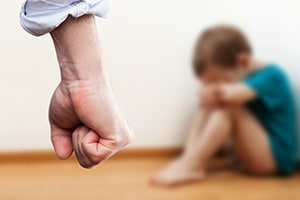Children and Physical Abuse
 Physical abuse against children is one of the most prevalent forms of child abuse that can cause serious physical, emotional and psychological damage to children during important formative stages of their lives. While parents are allowed to use limited force in disciplining their child, such as spanking, injuring a child or using an object or weapon when disciplining a child can lead to criminal charges against the child and the involvement of child protective services.
Physical abuse against children is one of the most prevalent forms of child abuse that can cause serious physical, emotional and psychological damage to children during important formative stages of their lives. While parents are allowed to use limited force in disciplining their child, such as spanking, injuring a child or using an object or weapon when disciplining a child can lead to criminal charges against the child and the involvement of child protective services.
Physical abuse may not always be obvious in children. Bumps and bruises are a normal part of an active child’s life, however, there are certain signs to look for when determining whether or not a child is a victim of physical abuse. A child suffering from physical abuse may have unexplained burns, bruises, broken bones or black eyes. After an absence from school, the child may have fading bruises or other visible marks. The child may appear frightened by his or her parents and may resist seeing them. The child may be unusually fearful of adults. The child may personally report the physical abuse.
A parent or caregiver may be suspected of physical abuse when they offer conflicting, unreasonable or no explanation about how a child was injured, describes their child as “evil” or otherwise in a consistently negative manner, uses severe methods of physical discipline against the child or has a history of abuse towards children or other household members.
Health Consequences of Physical AbuseEven after bruises and broken bones have healed, physical abuse can cause long-term trauma in children that often carries lifelong consequences. Children who are physically abused often experience cognitive delays and emotional problems. In addition, physical abuse can harm nervous system and immune system development, putting children who have suffered abuse at greater risk for health problems as adults. Researchers have found that three years following a child abuse investigation, 28 percent of the children involved had a chronic health condition. Infants who suffer head trauma or other physical injuries are especially susceptible to long-term physical effects, including brain damage and permanent disabilities.
Studies have shown that child abuse affects the development of certain areas of the brain. These can affect the development of child’s cognitive, linguistic and academic skills. Children who suffer from physical abuse can adopt a persistent fear state. While this is helpful to unaffected people in threatening situations, it can be counterproductive and even harmful when no such threat exists and can cause hyper-vigilance, anxiety and behavior impulsivity.
Research has also shown a link between childhood physical abuse and poor health as an adult. Adults who suffered abuse as a child are more likely to experience cardiovascular disease, lung and liver disease, hypertension, diabetes, asthma, and obesity. Physical abuse specifically is linked with an increased risk of diabetes and malnutrition.
Effect on Mental Health and Behavioral ConsequencesThose who experience childhood physical abuse are also more likely to suffer from mental health disorders. Childhood physical abuse is considered a risk factor for borderline personality disorder, depression and anxiety.
In addition, childhood physical abuse can have permanent effects on behavior. Children who suffer physical abuse are at a greater risk to repeat grades at school, substance abuse, delinquency, and truancy. Several studies have found a clear link between childhood abuse and future juvenile delinquency and adult criminality.
Parents who are physically abusive typically experienced physical abuse when they were children. Studies have shown that girls who experienced physical abuse were up to 7 percent more likely to commit violent acts as a child and up to 10 percent more likely to commit violence against a romantic partner or family member in their lifetime. Boys who are the victims of physical abuse are up to 12 percent more like to commit youth violence and up to 17 percent more likely to commit domestic abuse or child abuse as an adult.
 Child Criminal Safety Center Home
Child Criminal Safety Center Home